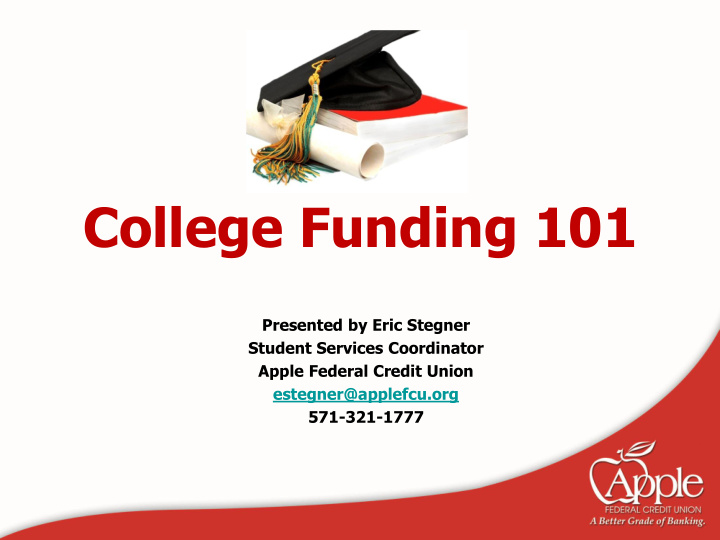



College Funding 101 Presented by Eric Stegner Student Services Coordinator Apple Federal Credit Union estegner@applefcu.org 571-321-1777
College is an Investment Average Annual Income High School Diploma $32,188 Associate Degree $39,884 Bachelor’s Degree $53,976 That’s $21,788 dollars annually Source: U.S. Bureau of Labor Statistics Current Population Survey 2010
Choosing a College What are my out of pocket expenses? Do I have the financial resources for this school? All colleges and universities are required to have a Net Price Calculator on their website. Net Price = Full Cost (Sticker Price) – Grants and Scholarships
Cost of Attendance (COA) The Cost of Attendance considers all cost associated with a student’s enrollment at a particular college or university. Components include: Tuition and fees Direct Costs Room and board Books and supplies Transportation Indirect Costs Miscellaneous Based on a student’s: Enrollment status Living arrangements State residency status
Cost of Attendance (cont..) Typical Costs for an In-State Resident Hall Student at Radford University 2012 – 2013 school year Tuition and Fees $8,590 Room and Board $7,498 Books and Supplies $1,100 Personal Expenses $1,900 Travel Expenses $1,400 Total $20,488
FAFSA Free Application for Federal Student Aid Opens January 1 st of upcoming current school term through June 30 th of ending school term. First time users apply for a PIN www.pin.ed.gov. Submit application on-line at www.fafsa.ed.gov. Should apply annually Priority Aid Deadlines will vary Check with your state and college for additional deadlines.
Expected Family Contribution (EFC) The EFC is a Federal calculation based on information provided in the FAFSA EFC takes into account: Income (parent(s) and student) Assets (parent(s) and student) Number in household Number in college State of residency Marital status Dependency status
Financial Need Cost of Attendance (COA) $20,000 Expected Family Contribution (EFC) $10,000 Need $10,000
Types of Aid Free Money – Grants and Scholarships Cheap Money – Direct Loans (Federal) Gap Money – PLUS Loans (Federal) – Alternative Loans (Private)
Grants (Free Money ) Federal Grants – Range from $100 to $5,550 Federal Pell Grant (Need based) Federal Supplemental Educational Opportunity Grant (Need based) State Grants Virginia Tuition Assistance Grant Institutional Grants Check with Financial Aid Office
Scholarships (Free Money) Scholarships – Amounts Vary Awarded based on need or merit Awarded for a variety of reasons: academics; sports; extra-curricular activities Resources include School Counselor / Career Center Specialist / Employer / Internet / College Financial Aid Office (FAO) Apple Education Foundation – 30 $4,000 Scholarships to Apple members – www.AFCUFoundation.org
Federal Student Loans (Cheap Money) Stafford Loans (2012 -2013 School Year) FDLP (Federal Direct Lending Program) Subsidized (Need based) Unsubsidized Based on need Not based on need Government pays interest Students are responsible while in school. Payment can for interest, may defer 6.8%* fixed interest rate be deferred. 3.4% fixed interest rate plus plus 1% origination fee 1% origination fee
Stafford Loan Limits Unsubsidized Subsidized Dependent Student Freshman $3,500 Freshman $5,500 Sophomore $4,500 Sophomore $6,500 Juniors & Seniors $5,500 Juniors & Seniors $7,500 Independent Student Freshman $9,500 Sophomore $10,500 Juniors & Seniors $12,500
Unmet Need (Money to fill the Gap) Savings Account College Savings Plans (529) PLUS (Parent Loan for Undergraduate Students) Alternative (Private) Loans – Apple’s Student Choice loan Home Equity Loans Credit Cards Retirement Account 401K Plans
PLUS Loan Parent Loan for Undergraduate Students (PLUS ) Often listed on Award Letter – 7.9% fixed interest rate – Available to parents of dependent students, graduate and professional students – Borrowers are subject to a credit check – 4% origination fee – Limit is the COA less any other Financial Aid – Payments begin 6 months after student drops below half time status or graduates – No prepayment penalty
Alternative (Private) Loans WHAT TO CONSIDER – Index Used Prime or LIBOR – Spread – Floor – Origination Fee – Repayment Terms – Borrower Benefits – Co-Borrower Options
Award Letters Compare apples to apples Out of pocket cost Requirements for grants and scholarships – Are they renewable? – Are they front-loaded? Ask how private scholarships are treated Payment plans You do not have to accept everything that is awarded by the school
Deadlines Start filling out the FAFSA January 1 Priority Deadline for aid Feb – April Admissions decisions arrive March - April Award letters sent out April Notify school of intention By May 1 Payment due End of July State and institutional deadlines may vary
Websites Federal Government www.studentaid.ed.gov www.nces.ed.gov/collegenavigator/ www.gibill.va.gov/benefits/post_911_gibill/yellow_ribbon _program.html General Knowledge / Scholarships www.bigfuture.org www.finaid.org www.fastweb.com www.meritaid.com http://studentnpc.collegeboard.org/ (Net Price Calculator) Federal Student Information Center 1-800-4-FED-AID
Questions?
Recommend
More recommend